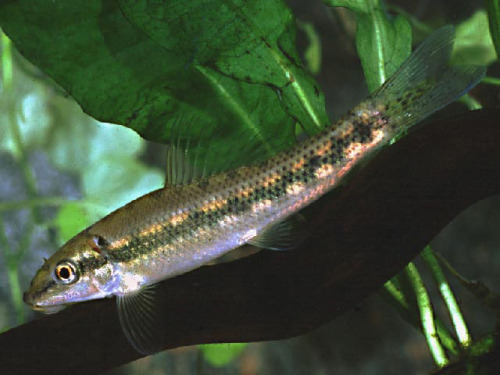Chinese Algae Eater Care Sheet
(not my photo)
Name: Gyrinocheilus aymonieri, Chinese Algae Eater
Lifespan: 6-8 years
Adult Size: 8-11" (20-27cm)
Fresh or Salt Water: Fresh
Maintenance Level: Medium
Tank Region: Bottom
Temperature range: 76-82F (25-28C) these are tropical fish that need a stable temperature. Do not rely on a window to heat any tank and instead invest in a submersible heater and a thermometer. Do not use stick on thermometers as they are inaccurate.
pH range: Neutral to acidic 6.8-7.5 Make sure to treat all water with water conditioner.
gh/kh: Mostly soft 5 - 20°dGH
Diet: Omnivores. They do scavenge for dead fish and will take almost any sinking food. Should be fed algae wafers along with shrimp pellets, sinking pellets or flakes, mysis shrimp, bloodworms, and brine shrimp for protein. Romaine lettuce or spinach leaves and zucchini add variety. Many algae wafers are actually made with fish meal so check the ingredients list. Look for spirulina, seaweed meal, and algae meal. In the wild this fish is scavenging the riverbottom looking for recently deceased fish, small invertebrates, algae and edible plants. They eat a wide variety of food. So providing them with this variety in captivity is only natural, and a healthy diet is extremely important in keeping healthy long lived fish.
Aggression Level and social characteristics: Semi-Aggressive. As they get older, they can get very territorial and attack other fish, or feed off of their slime coat as they sleep. Do not keep with large slow moving fish like goldfish, angelfish, and discus. These fish can be trouble makers, so watch out.
Appearance: Long cylindrical fish with downward facing suction cup-like mouths. They are brown with black spots or horizontal stripes running down their sides, and have a black or dark brown back. They also come in solid yellow and a marbled variety that is black and yellow.
Sexing: Males have more pronounced “thorns” around the mouth. These thorns look like small bumps. Females have less of them, and they are smaller. Females are rounder bodied than males. Sexing can be difficult when the fish are young.
Reproductive Method and breeding: Egglayers, breeding is rare in aquariums. This fish is known to migrate to deeper water with less of a current to breed.
Acceptable tank mates: Small tropical fish that dwell near the top of the tank, tolerate the same pH, temperature range, and current such as; rasboras, serpae tetras, barbs, botias, zebra danios, and some have had success with cichlids. Keeping males with other males can result in fights, it is recommended to keep them singularly or in pairs.
Tank set up and minimum tank size: 40 gallons (152L), preferably with a medium to strong current. Offer many hiding places on the bottom of the tank such as broken terra cotta pots, rocks, driftwood, commercial decorations, and boulders. Preferred substrate is gravel mixed with sand and river rock. Most plants will not thrive in set ups like this; but Java fern, some species of Anubias, and Java moss tied to rocks can do well with sufficient light. (1.5 watts per gallon) Driftwood may be used to naturally lower the pH as well as add hiding places in the tank.
Distribution: Northern India to Central Thailand in relatively shallow fast moving streams. Specifically the Mae Klong, Chao Phraya, Middle/Lower Mekong and Dong Nai river basins, as well as parts of Vietnam.
Conclusion:
Chinese Algae Eaters are a boisterous fish and not a good choice for all aquariums. Often times they are bought young to control algae only to grow large and become aggressive with other fish. This fish was once thought to be a species of loach but is now in it’s own genus. They aren’t the best at controlling algae, despite their name. Chinese Algae Eaters only eat certain kinds of algae, and only when they feel like it. They prefer aquatic plants, lettuce, and algae discs to actual algae. They appreciate hiding places so they can feel secure, though they aren’t complete shut-ins. You will see this fish suctioned onto the side of your aquarium often, or hanging off of decorations. This fish has a unique adaptation. It has two gill slits, one to allow water in and one to expel water. This allows it to breath without taking it’s mouth off of rocks and to stay anchored in fast moving currents.
ambystonatechniality reblogged this from scalestails
ambystonatechniality liked this
pompytt liked this
flockofteeth liked this
kyaneos-blog1 liked this
scalestails posted this

